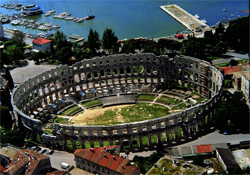 At the southern tip of Istria is Pula, its largest city and commercial centre. The city’s landmark, a Roman amphitheatre built of white limestone in the first century, rises high in a leafy district of the old city. It is supposed to be the third largest in the world. Standing there, you can picture a scene of some two thousand years ago when twenty thousand people cheered on the gladiator fights. Today the amphitheatre is the venue for a film festival, operas and rock concerts.
At the southern tip of Istria is Pula, its largest city and commercial centre. The city’s landmark, a Roman amphitheatre built of white limestone in the first century, rises high in a leafy district of the old city. It is supposed to be the third largest in the world. Standing there, you can picture a scene of some two thousand years ago when twenty thousand people cheered on the gladiator fights. Today the amphitheatre is the venue for a film festival, operas and rock concerts.
A short walk from the amphitheatre is the Portarata Square flanked by the Triumphal Arch of Sergius. Many artists, including Michelangelo, studied the Arch's classical proportions. The Arch is also an entrance to Ulica Sergijevaca, a busy, pedestrian-only street that follows the ring layout of the original Roman city and brings you to the Temple of Augustus. Passing through the arch, on your right is a nice building that was once a Berlitz school where James Joyce taught English at the beginning of the 20th century.
Pula is a haven for yachtsmen, with three marinas in its vicinity. Most of the beaches are out of the Pula centre, the ones on Verudela are about 4km away where a number of hotel resorts are situated as well.
Just off the coast from Pula are the Brijuni islands; their fourteen islands are the most interesting and indented group of islands in Istria. The abundance of flora creates a unique green landscape which is the habitat of numerous bird species, deer, mouflon, and other game. It was a residence of the late Yugoslav President Tito, and many came to the islands as his guests, including Elizabeth Taylor and Sofia Loren, nowadays the likes of John Malkovich and Vanessa Redgrave. Today the islands are a national park, the only one in Istria. If you're not staying in one of the villas that are open to the public now, you can visit them only in tour groups conducted around the villas and through the safari park in tourist trains.
A short ride from Pula, on the road to Rovinj, is Vodnjan, a pretty town known for its 18th-century Baroque Church of St. Blaise with mummified saints, relics enclosed in glass, and the 14th-century polyptych painted by Paolo Veneziano.